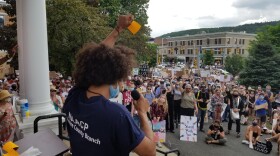The virtual presentations are titled “Casting Their Own Light: Perspectives on Berkshires Black History.”
“The three lectures emanate from a larger project that I started really over the pandemic to look at recreating the lives and sort of family histories of Black and mixed-race people in Berkshire County before 1865, before the end of the US Civil War," said Dr. Cynthia Farr Brown, president of the board of the Berkshire County Historical Society. “This project is modeled very closely on a similar project about Black families in Hampden County that was published a number of years ago by Joseph Carvalho III. And he spent many years in, really, a pre-digital age, researching and putting together databases and publications that outlined Black individuals and families and their contributions, their movements through Hampden County, and so on. We really have nothing like that for Berkshire County. There have been some individual case studies, there's certainly been some important books published, but the sort of whole scope and some detail is lacking- And so that was something that I was curious to try to probe and see what I could find.”
The first lecture, today at 5, is “Pittsfield’s First Black Neighborhoods: Thoughts on Black Community in 19th Century Pittsfield.”
“Sometimes when you go through records, what you get are pictures of individuals or facts about individuals," said Brown. "And I wanted to try to put the individuals into a wider context. What were the communities, the organizations, and the groups that they affiliated with? And who are the families who were settled over multiple generations in Pittsfield? And where do they come from? And where did they go?”
Brown’s early findings point to two or three Black Pittsfield neighborhoods forming as early as the late 18th Century as people left or escaped enslavement and sought a new start.
“I have found something that I think is pretty significant in terms of a very early neighborhood in Pittsfield," she told WAMC. "And then another neighborhood or grouping, community, in a place where I didn't expect to find it and that was long-standing and seemed to also involve a pretty representative group of white families and individuals who were willing and able to, for example, sell land, sell property to Black individuals, and that allowed this neighborhood, this group, to persist for decades, actually, in the part of Pittsfield where I found them.”
She cross-checked her research against other histories and newspaper archives and found no mention of what she says might constitute a unique discovery.
“I think it's highly suggestive of the fact that there are still things to be discovered out there that are going to inform and open our eyes in a new way about the history of people in the Berkshires," said Brown. "And that you never know. Going back through old stuff that's been around for a while, but that people haven't gone through with fresh eyes in a while, can be very revealing. I think it's also the case that when I put up, literally, some of the census pages from the 1850s, it will be startling to people what the neighborhood looked like in the south central neighborhood that I'm going to be talking about.”
On March 23rd, Brown’s second lecture – “Women of Color in the Berkshires Before 1850” – explores the lives of Polly Williams, Adeline Grant, and Sarah Askins.
“I've chosen three women who spent the majority of their life in different parts of the county and who have different kinds of connections to the county, and contributed to their communities, have some very interesting family ties of their own, to really try to represent the richness and the variety of lives of women of color in the Berkshires, again, in a sort of pre-Civil War period,” Brown told WAMC.
The final talk on April 13th is titled “From the Slave’s Cause to Civil Rights: Community and Liberty in the Berkshires before 1909.” Brown says it will challenge conventional notions that civil rights and emancipation happened in a progressive, linear manner in the predominantly white region.
“I have some examples that I will share from the Berkshires to show how that actually was not the case," she said. "I also think that a new wave of scholarship around Black and Indigenous history is really about self-efficacy and about the fact that Black, Indigenous, and mixed-race people have always been at the forefront of their own emancipation and creation of pathways to more rights and equality. And I think bringing that to bear on the history of the Berkshires is important, because that tells us that we should be looking for, who were the individuals and the groups who were leading their own efforts for self-emancipation and for a wider scope of rights, that it wasn't always or even a lot, sometimes, about white people leading those movements or feeding those movements. So, what should we be on the lookout for? And how can we tell this story in a more honest way? And it's a more complicated story. But it's, I think, a better story than the one that we typically tell.”









